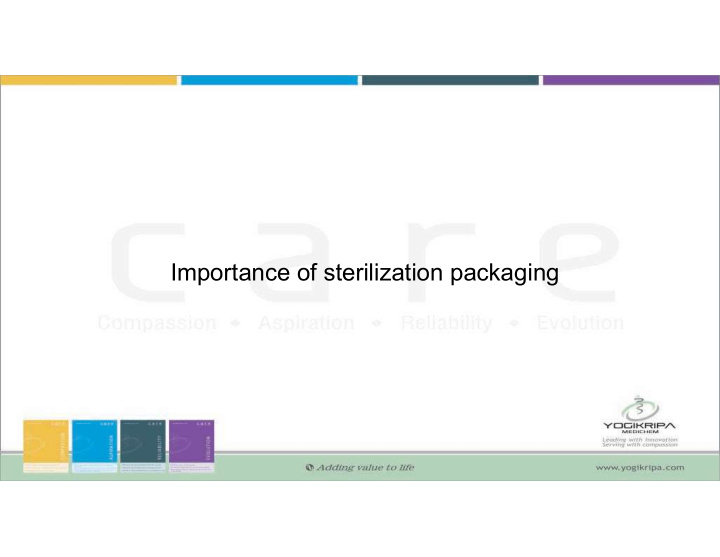



Importance of sterilization packaging
every chain is only as strong as its weakest link
Because of That…. …the international ISO committee decided to handle the packaging process as an integral part of the instrumental preparation process
ISO / EN Requirements on Packaging & Sealers
ISO 11607-1:2006 ISO 11607-1:2006 is applicable to industry, to health care facilities, and wherever medical devices are placed in sterile barrier systems and sterilized. ISO 11607-1:2006 specifies the requirements and test methods for materials, preformed sterile barrier systems, sterile barrier systems and packaging systems that are intended to maintain sterility of terminally sterilized medical devices until the point of use.
ISO 11607-2:2006 ISO 11607-2:2006 is applicable to industry, to health care facilities, and wherever medical devices are packaged and sterilized. ISO 11607-2:2006 specifies the requirements for development and validation of processes for packaging medical devices that are terminally sterilized. These processes include forming, sealing, and assembly of preformed sterile barrier systems, sterile barrier systems and packaging systems.
ISO/TS 16775:2014 ISO/TS 16775:2014 provides guidance for the application of the requirements contained in ISO 11607-1 and ISO 11607-2. It does not add to, or otherwise change, the requirements of ISO 11607-1 and/or ISO 11607-2. It is an informative document, not normative, and does not include requirements to be used as basis of regulatory inspection or certification assessment activities.
EN 868 series The adoption of the ISO 11607 series of standards in Europe in 2006 affected the existing European Standards in the EN 868 series . EN 868-1:1997 which provided general requirements for packaging materials for sterile medical devices, was withdrawn and replaced by EN ISO 11607-1 in 2006 The remaining EN 868 standards, however, remain and revised editions have been published between 2017 and 2019. This series comprises Parts 2 to 10. The EN 868 series provides requirements and test methods for a range of specific materials and configurations of sterile barrier systems.
EN868 now comprises the following : Part 2: Sterilization wrap; Part 3: Paper for use in the manufacture of paper bags and pouches and reels; Part 4: Paper bags; Part 5: Sealable pouches and reels of porous materials and plastic film construction; Part 6: Paper for low temperature sterilization; Part 7: Adhesive coated paper for low temperature sterilization processes; Part 8: Re-usable sterilization containers for steam sterilizers; Part 9: Uncoated nonwoven materials of polyolefines; Part 10: Adhesive coated nonwoven materials of polyolefines.
EN 868-5 – European packaging standard
EN 868-5 – European packaging standard Requirements on packaging & sealers effective barrier maintain sterility aspetic presentation suitable heat sealer regular checks of sealed packs routinely monitored
ISO 11607-2 – International validation standard
ISO 11607-2:2006 – international validation standard
ISO 11607-2:2006 – international validation standard requirements validatable packaging process critical parameters shall be controlled alarm systems and/or machine stop in case of parameter deviation routine critical parameter monitoring
Summary EN 868-5 and ISO 11607-2 suitable heat sealer critical parameters shall be controlled alarm systems and/or machine stop in case of critical parameter deviation validatable monitoring and checking routine critical parameter monitoring regular checks of sealed packs
problem 1: unprofessional sealers simple bar- or pedal sealers are not accaptable in CSSDs or doctor‘s surgeries. sealing line is mostly not wide enough (<6mm)! process doesn‘t run automatically parameters are not under control! parameters cannot be documented
problem 1: unprofessional sealers As the sealing result is up to the motivation of the user, the packages are either open or fusioned!
problem 2: self sealing pouches A professional study by the University of Tübingen (Germany) found that of 147 professionally closed self seal pouches 47 were leaky ( Residual Risk of more that 30%)
Summary Sealing process parameters are (see ISO/TS 16775): - temperature - contact pressure Sealing process parameters have to be monitored and documented Heat sealing devices must be Validateable
Routine Monitoring
chapter 8.6. Routine Monitoring
EN 868-5 is referring to ISO 11607-1 Annex B for seal integrity tests: Routine Monitoring ISO 11607-1 Annex B is referring to ASTM F 1929 for seal integrity testing: Leak Test / InkTest InkTests are also available for Tyvek (HDPE) and ULTRA
Alternative: SEAL CHECK 1.seal 2.compare
Alternative: SEAL CHECK problems can be easily identified with the SEAL CHECK please make sure that the SEAL CHECK consists of Medical paper (some manufacturers use simple writing paper)
All final product of sterilization packaging are tested for compliance to ISO 11607-1, ISO 11140-1 and EN 868-5 for specific properties listed in below table.
Labelling and documentation
Labelling and documentation (link to www.hawo.TV for the video)
Routine Monitoring
Routine Monitoring https://youtu.be/VPvfDI1lXcY
Remember international standard require validation sealers shall monitor the critical process parameters Temperature Contact pressure hawo sealers with the ‚-V‘ at the end fulfil the requirements use a suitable monitoring system (e.g. seal check or inkTest) maintain the sealer annually
(Yogi Kripa Medi Chem Pvt. Ltd.)
Recommend
More recommend